Research Proposal: Customer Purchase Behavior in Tyre Retailers
VerifiedAdded on 2023/06/05
|12
|3156
|115
Project
AI Summary
This research proposal investigates the impact of store environment factors on customer purchase behavior and retention within the tyre retail industry. The study aims to identify environmental issues, evaluate consumer perceptions of ambience, and recommend strategies for improving the retail environment. The research will focus on ambient, design, and social factors, utilizing a descriptive research design with structured questionnaires to collect primary data from customers. The methodology includes convenience sampling and quantitative data analysis to explore the relationship between store environment and customer purchase decisions. The proposal includes a literature review covering retailer definitions, retail mix strategies, store attractiveness theory, and specific factors like ambient, design, and social elements. The study seeks to provide actionable insights for tyre retailers to enhance customer experience and increase market share.
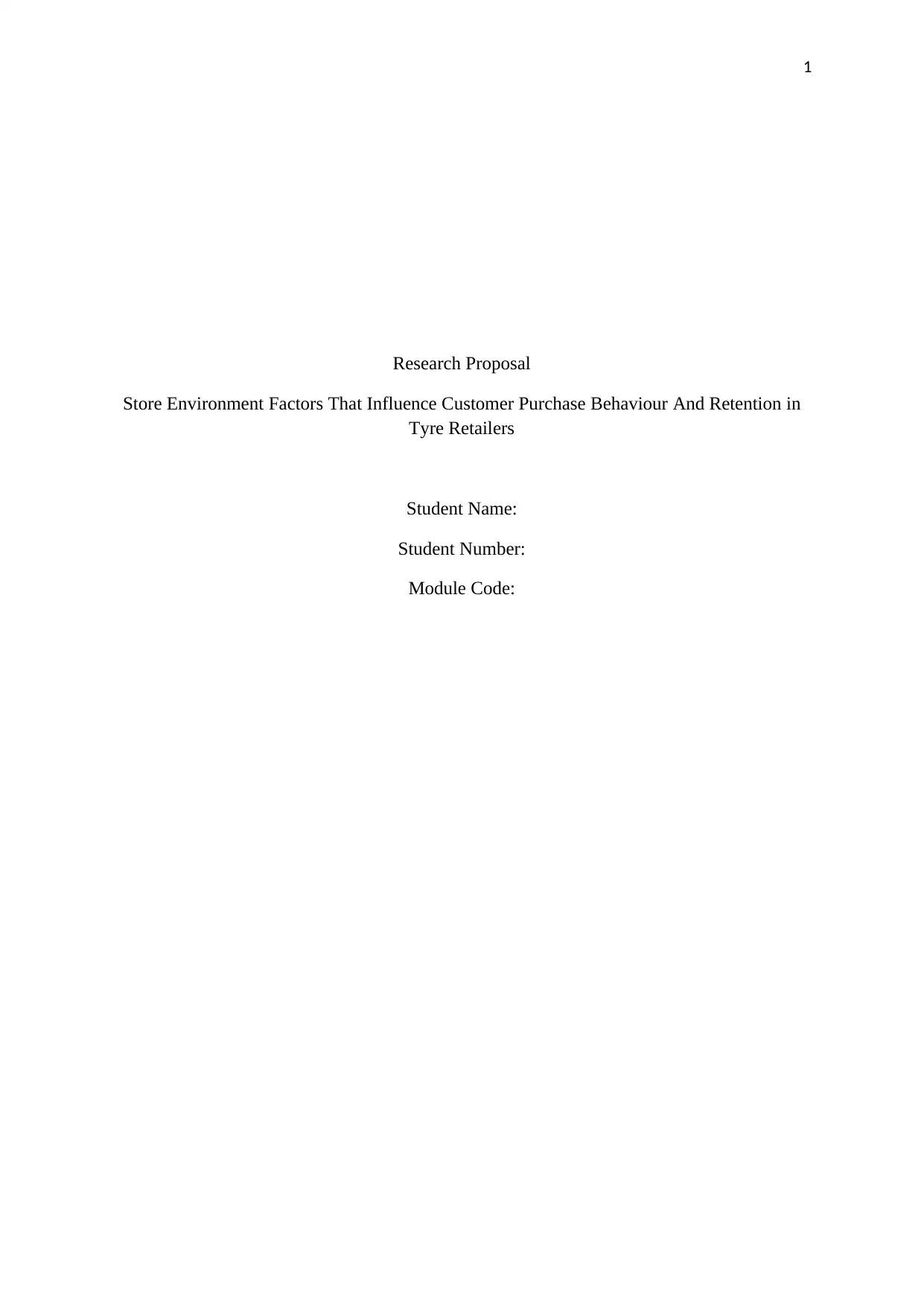
1
Research Proposal
Store Environment Factors That Influence Customer Purchase Behaviour And Retention in
Tyre Retailers
Student Name:
Student Number:
Module Code:
Research Proposal
Store Environment Factors That Influence Customer Purchase Behaviour And Retention in
Tyre Retailers
Student Name:
Student Number:
Module Code:
Paraphrase This Document
Need a fresh take? Get an instant paraphrase of this document with our AI Paraphraser
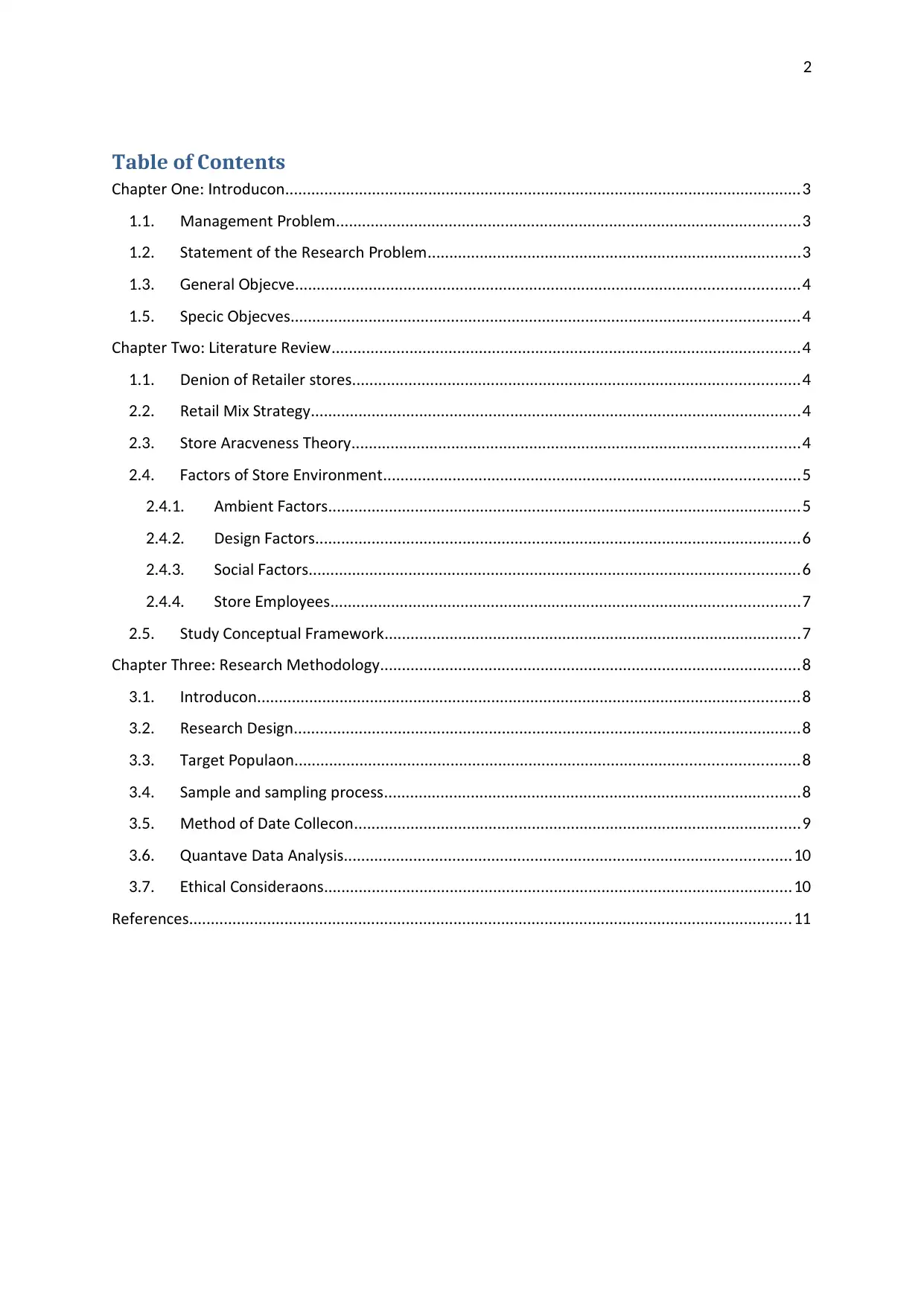
2
Table of Contents
Chapter ne ntroductionO : I .......................................................................................................................3
1.1. Management roblemP ...........................................................................................................3
1.2. Statement of the Research roblemP ......................................................................................3
1.3. eneral bjectiveG O ....................................................................................................................4
1.5. Specific bjectivesO .....................................................................................................................4
Chapter wo iterature ReviewT : L ............................................................................................................4
1.1. Definition of Retailer stores.......................................................................................................4
2.2. Retail Mi Strategyx .................................................................................................................4
2.3. Store Attractiveness heoryT .......................................................................................................4
2.4. actors of Store nvironmentF E ................................................................................................5
2.4.1. Ambient actorsF .............................................................................................................5
2.4.2. Design actorsF ................................................................................................................6
2.4.3. Social actorsF .................................................................................................................6
2.4.4. Store mployeesE ............................................................................................................7
2.5. Study Conceptual rameworkF ................................................................................................7
Chapter hree Research MethodologyT : .................................................................................................8
3.1. ntroductionI .............................................................................................................................8
3.2. Research Design.....................................................................................................................8
3.3. arget opulationT P ....................................................................................................................8
3.4. Sample and sampling process................................................................................................8
3.5. Method of Date Collection.......................................................................................................9
3.6. uantitative Data AnalysisQ .......................................................................................................10
3.7. thical ConsiderationsE ............................................................................................................10
References...........................................................................................................................................11
Table of Contents
Chapter ne ntroductionO : I .......................................................................................................................3
1.1. Management roblemP ...........................................................................................................3
1.2. Statement of the Research roblemP ......................................................................................3
1.3. eneral bjectiveG O ....................................................................................................................4
1.5. Specific bjectivesO .....................................................................................................................4
Chapter wo iterature ReviewT : L ............................................................................................................4
1.1. Definition of Retailer stores.......................................................................................................4
2.2. Retail Mi Strategyx .................................................................................................................4
2.3. Store Attractiveness heoryT .......................................................................................................4
2.4. actors of Store nvironmentF E ................................................................................................5
2.4.1. Ambient actorsF .............................................................................................................5
2.4.2. Design actorsF ................................................................................................................6
2.4.3. Social actorsF .................................................................................................................6
2.4.4. Store mployeesE ............................................................................................................7
2.5. Study Conceptual rameworkF ................................................................................................7
Chapter hree Research MethodologyT : .................................................................................................8
3.1. ntroductionI .............................................................................................................................8
3.2. Research Design.....................................................................................................................8
3.3. arget opulationT P ....................................................................................................................8
3.4. Sample and sampling process................................................................................................8
3.5. Method of Date Collection.......................................................................................................9
3.6. uantitative Data AnalysisQ .......................................................................................................10
3.7. thical ConsiderationsE ............................................................................................................10
References...........................................................................................................................................11
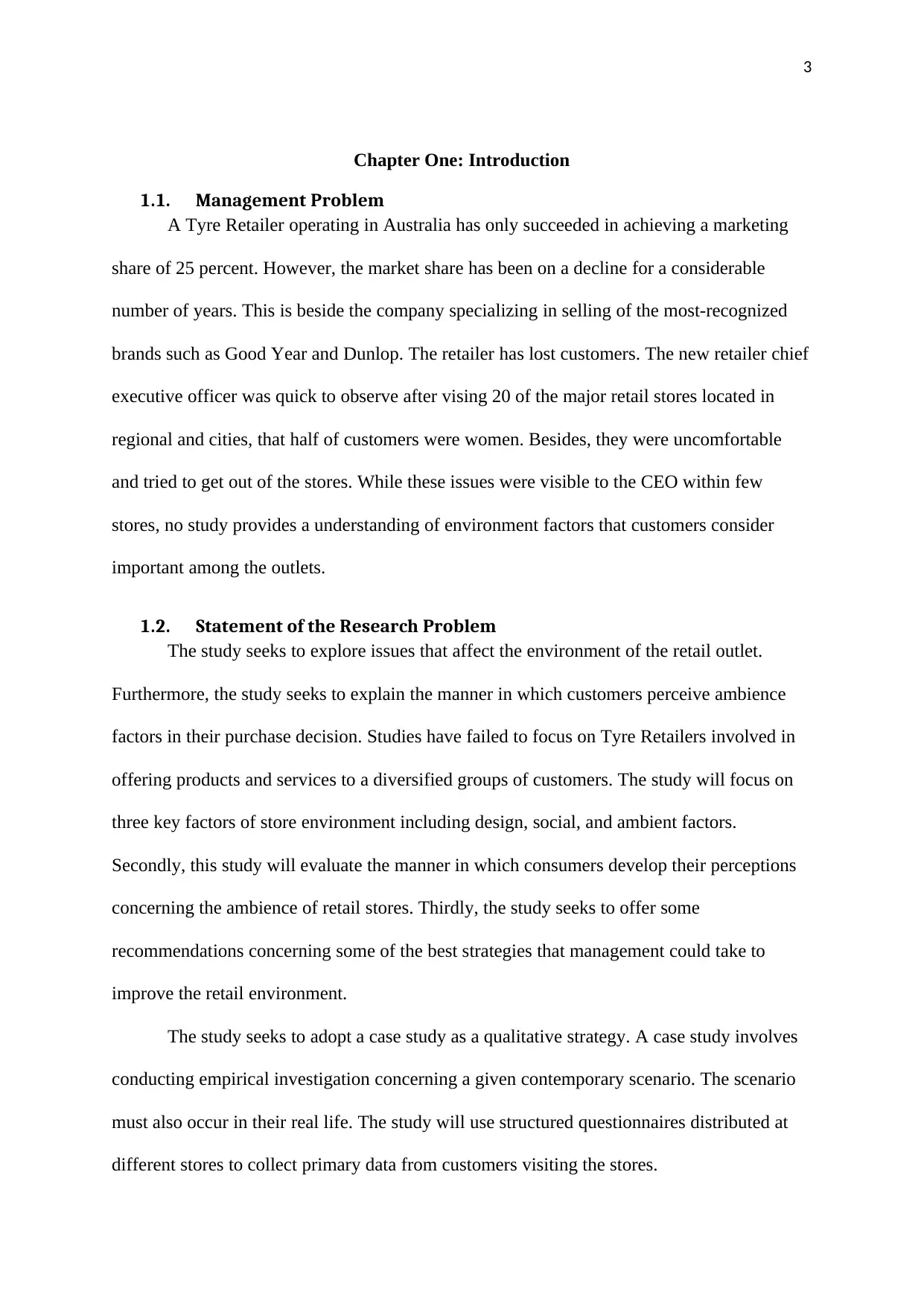
3
Chapter One: Introduction
1.1. Management Problem
A Tyre Retailer operating in Australia has only succeeded in achieving a marketing
share of 25 percent. However, the market share has been on a decline for a considerable
number of years. This is beside the company specializing in selling of the most-recognized
brands such as Good Year and Dunlop. The retailer has lost customers. The new retailer chief
executive officer was quick to observe after vising 20 of the major retail stores located in
regional and cities, that half of customers were women. Besides, they were uncomfortable
and tried to get out of the stores. While these issues were visible to the CEO within few
stores, no study provides a understanding of environment factors that customers consider
important among the outlets.
1.2. Statement of the Research Problem
The study seeks to explore issues that affect the environment of the retail outlet.
Furthermore, the study seeks to explain the manner in which customers perceive ambience
factors in their purchase decision. Studies have failed to focus on Tyre Retailers involved in
offering products and services to a diversified groups of customers. The study will focus on
three key factors of store environment including design, social, and ambient factors.
Secondly, this study will evaluate the manner in which consumers develop their perceptions
concerning the ambience of retail stores. Thirdly, the study seeks to offer some
recommendations concerning some of the best strategies that management could take to
improve the retail environment.
The study seeks to adopt a case study as a qualitative strategy. A case study involves
conducting empirical investigation concerning a given contemporary scenario. The scenario
must also occur in their real life. The study will use structured questionnaires distributed at
different stores to collect primary data from customers visiting the stores.
Chapter One: Introduction
1.1. Management Problem
A Tyre Retailer operating in Australia has only succeeded in achieving a marketing
share of 25 percent. However, the market share has been on a decline for a considerable
number of years. This is beside the company specializing in selling of the most-recognized
brands such as Good Year and Dunlop. The retailer has lost customers. The new retailer chief
executive officer was quick to observe after vising 20 of the major retail stores located in
regional and cities, that half of customers were women. Besides, they were uncomfortable
and tried to get out of the stores. While these issues were visible to the CEO within few
stores, no study provides a understanding of environment factors that customers consider
important among the outlets.
1.2. Statement of the Research Problem
The study seeks to explore issues that affect the environment of the retail outlet.
Furthermore, the study seeks to explain the manner in which customers perceive ambience
factors in their purchase decision. Studies have failed to focus on Tyre Retailers involved in
offering products and services to a diversified groups of customers. The study will focus on
three key factors of store environment including design, social, and ambient factors.
Secondly, this study will evaluate the manner in which consumers develop their perceptions
concerning the ambience of retail stores. Thirdly, the study seeks to offer some
recommendations concerning some of the best strategies that management could take to
improve the retail environment.
The study seeks to adopt a case study as a qualitative strategy. A case study involves
conducting empirical investigation concerning a given contemporary scenario. The scenario
must also occur in their real life. The study will use structured questionnaires distributed at
different stores to collect primary data from customers visiting the stores.
⊘ This is a preview!⊘
Do you want full access?
Subscribe today to unlock all pages.

Trusted by 1+ million students worldwide
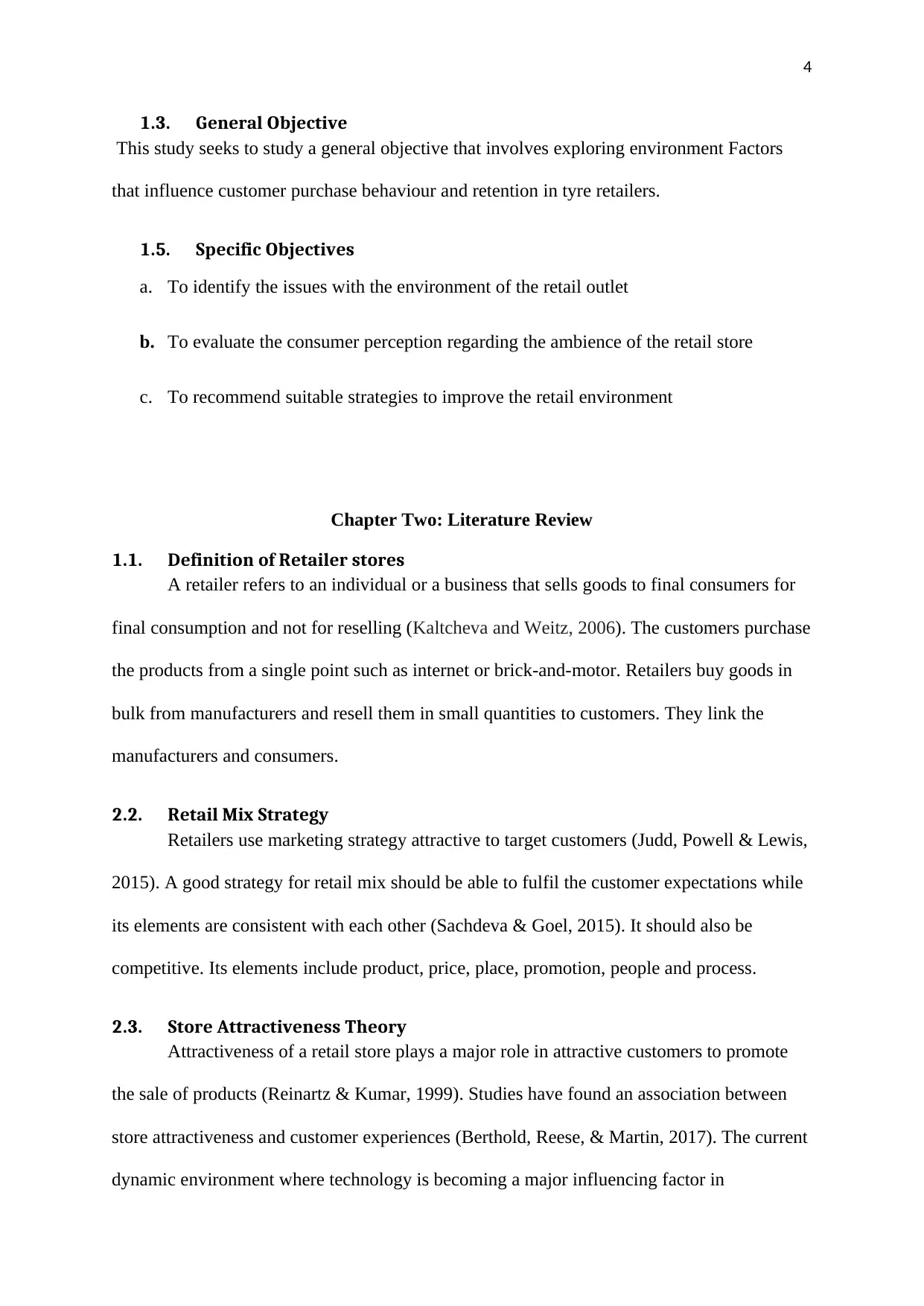
4
1.3. General Objective
This study seeks to study a general objective that involves exploring environment Factors
that influence customer purchase behaviour and retention in tyre retailers.
1.5. Specific Objectives
a. To identify the issues with the environment of the retail outlet
b. To evaluate the consumer perception regarding the ambience of the retail store
c. To recommend suitable strategies to improve the retail environment
Chapter Two: Literature Review
1.1. Definition of Retailer stores
A retailer refers to an individual or a business that sells goods to final consumers for
final consumption and not for reselling (Kaltcheva and Weitz, 2006). The customers purchase
the products from a single point such as internet or brick-and-motor. Retailers buy goods in
bulk from manufacturers and resell them in small quantities to customers. They link the
manufacturers and consumers.
2.2. Retail Mix Strategy
Retailers use marketing strategy attractive to target customers (Judd, Powell & Lewis,
2015). A good strategy for retail mix should be able to fulfil the customer expectations while
its elements are consistent with each other (Sachdeva & Goel, 2015). It should also be
competitive. Its elements include product, price, place, promotion, people and process.
2.3. Store Attractiveness Theory
Attractiveness of a retail store plays a major role in attractive customers to promote
the sale of products (Reinartz & Kumar, 1999). Studies have found an association between
store attractiveness and customer experiences (Berthold, Reese, & Martin, 2017). The current
dynamic environment where technology is becoming a major influencing factor in
1.3. General Objective
This study seeks to study a general objective that involves exploring environment Factors
that influence customer purchase behaviour and retention in tyre retailers.
1.5. Specific Objectives
a. To identify the issues with the environment of the retail outlet
b. To evaluate the consumer perception regarding the ambience of the retail store
c. To recommend suitable strategies to improve the retail environment
Chapter Two: Literature Review
1.1. Definition of Retailer stores
A retailer refers to an individual or a business that sells goods to final consumers for
final consumption and not for reselling (Kaltcheva and Weitz, 2006). The customers purchase
the products from a single point such as internet or brick-and-motor. Retailers buy goods in
bulk from manufacturers and resell them in small quantities to customers. They link the
manufacturers and consumers.
2.2. Retail Mix Strategy
Retailers use marketing strategy attractive to target customers (Judd, Powell & Lewis,
2015). A good strategy for retail mix should be able to fulfil the customer expectations while
its elements are consistent with each other (Sachdeva & Goel, 2015). It should also be
competitive. Its elements include product, price, place, promotion, people and process.
2.3. Store Attractiveness Theory
Attractiveness of a retail store plays a major role in attractive customers to promote
the sale of products (Reinartz & Kumar, 1999). Studies have found an association between
store attractiveness and customer experiences (Berthold, Reese, & Martin, 2017). The current
dynamic environment where technology is becoming a major influencing factor in
Paraphrase This Document
Need a fresh take? Get an instant paraphrase of this document with our AI Paraphraser
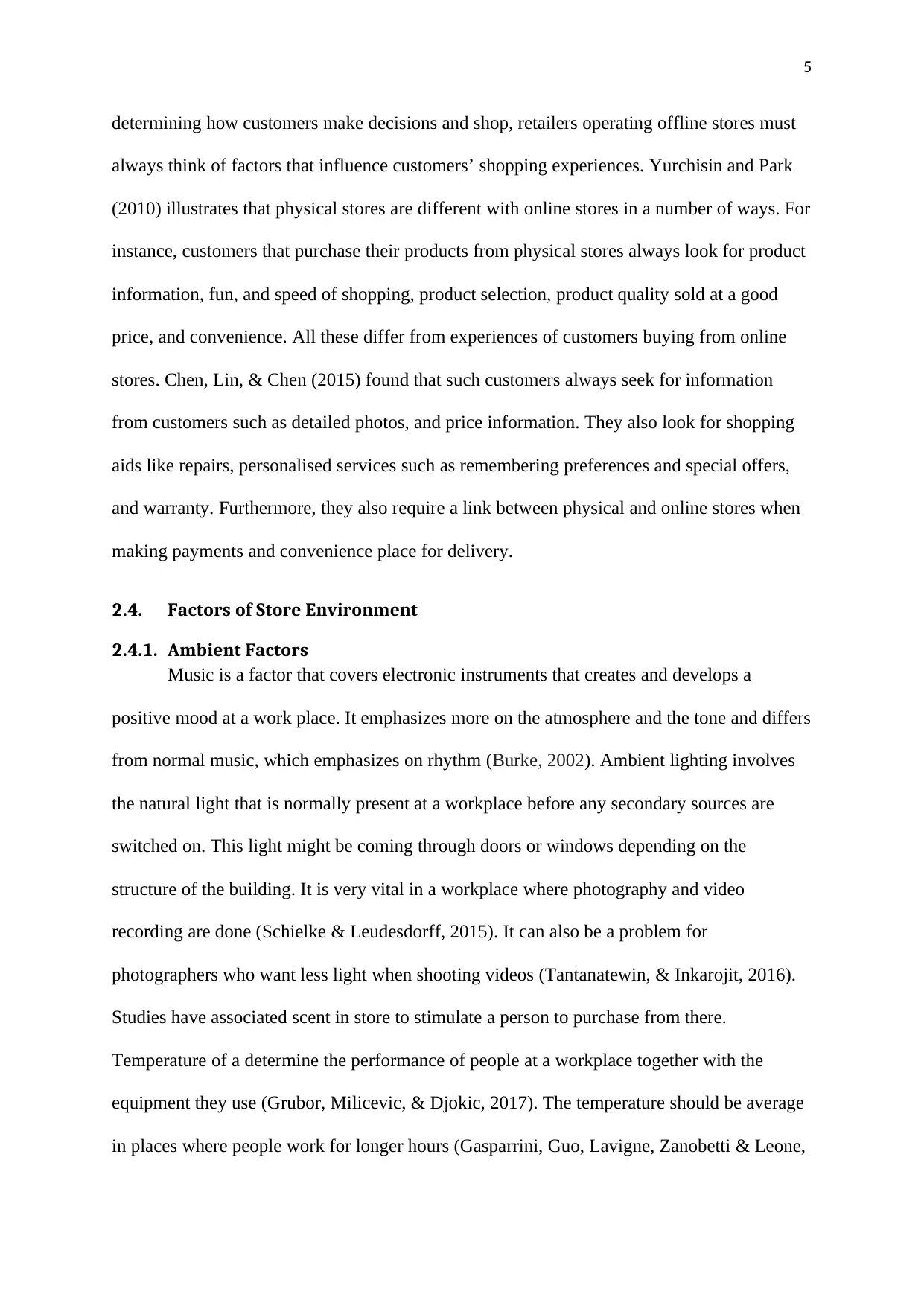
5
determining how customers make decisions and shop, retailers operating offline stores must
always think of factors that influence customers’ shopping experiences. Yurchisin and Park
(2010) illustrates that physical stores are different with online stores in a number of ways. For
instance, customers that purchase their products from physical stores always look for product
information, fun, and speed of shopping, product selection, product quality sold at a good
price, and convenience. All these differ from experiences of customers buying from online
stores. Chen, Lin, & Chen (2015) found that such customers always seek for information
from customers such as detailed photos, and price information. They also look for shopping
aids like repairs, personalised services such as remembering preferences and special offers,
and warranty. Furthermore, they also require a link between physical and online stores when
making payments and convenience place for delivery.
2.4. Factors of Store Environment
2.4.1. Ambient Factors
Music is a factor that covers electronic instruments that creates and develops a
positive mood at a work place. It emphasizes more on the atmosphere and the tone and differs
from normal music, which emphasizes on rhythm (Burke, 2002). Ambient lighting involves
the natural light that is normally present at a workplace before any secondary sources are
switched on. This light might be coming through doors or windows depending on the
structure of the building. It is very vital in a workplace where photography and video
recording are done (Schielke & Leudesdorff, 2015). It can also be a problem for
photographers who want less light when shooting videos (Tantanatewin, & Inkarojit, 2016).
Studies have associated scent in store to stimulate a person to purchase from there.
Temperature of a determine the performance of people at a workplace together with the
equipment they use (Grubor, Milicevic, & Djokic, 2017). The temperature should be average
in places where people work for longer hours (Gasparrini, Guo, Lavigne, Zanobetti & Leone,
determining how customers make decisions and shop, retailers operating offline stores must
always think of factors that influence customers’ shopping experiences. Yurchisin and Park
(2010) illustrates that physical stores are different with online stores in a number of ways. For
instance, customers that purchase their products from physical stores always look for product
information, fun, and speed of shopping, product selection, product quality sold at a good
price, and convenience. All these differ from experiences of customers buying from online
stores. Chen, Lin, & Chen (2015) found that such customers always seek for information
from customers such as detailed photos, and price information. They also look for shopping
aids like repairs, personalised services such as remembering preferences and special offers,
and warranty. Furthermore, they also require a link between physical and online stores when
making payments and convenience place for delivery.
2.4. Factors of Store Environment
2.4.1. Ambient Factors
Music is a factor that covers electronic instruments that creates and develops a
positive mood at a work place. It emphasizes more on the atmosphere and the tone and differs
from normal music, which emphasizes on rhythm (Burke, 2002). Ambient lighting involves
the natural light that is normally present at a workplace before any secondary sources are
switched on. This light might be coming through doors or windows depending on the
structure of the building. It is very vital in a workplace where photography and video
recording are done (Schielke & Leudesdorff, 2015). It can also be a problem for
photographers who want less light when shooting videos (Tantanatewin, & Inkarojit, 2016).
Studies have associated scent in store to stimulate a person to purchase from there.
Temperature of a determine the performance of people at a workplace together with the
equipment they use (Grubor, Milicevic, & Djokic, 2017). The temperature should be average
in places where people work for longer hours (Gasparrini, Guo, Lavigne, Zanobetti & Leone,
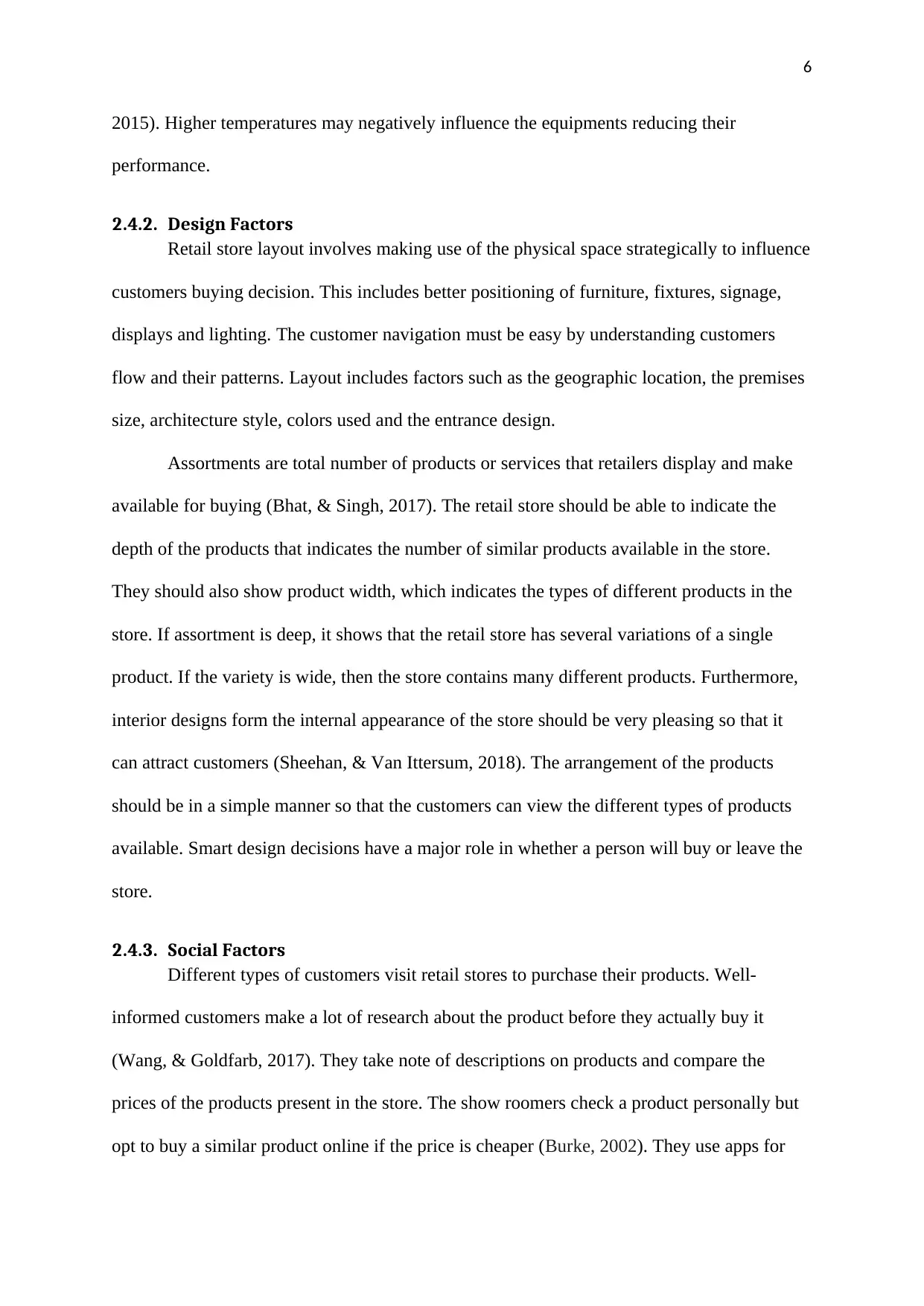
6
2015). Higher temperatures may negatively influence the equipments reducing their
performance.
2.4.2. Design Factors
Retail store layout involves making use of the physical space strategically to influence
customers buying decision. This includes better positioning of furniture, fixtures, signage,
displays and lighting. The customer navigation must be easy by understanding customers
flow and their patterns. Layout includes factors such as the geographic location, the premises
size, architecture style, colors used and the entrance design.
Assortments are total number of products or services that retailers display and make
available for buying (Bhat, & Singh, 2017). The retail store should be able to indicate the
depth of the products that indicates the number of similar products available in the store.
They should also show product width, which indicates the types of different products in the
store. If assortment is deep, it shows that the retail store has several variations of a single
product. If the variety is wide, then the store contains many different products. Furthermore,
interior designs form the internal appearance of the store should be very pleasing so that it
can attract customers (Sheehan, & Van Ittersum, 2018). The arrangement of the products
should be in a simple manner so that the customers can view the different types of products
available. Smart design decisions have a major role in whether a person will buy or leave the
store.
2.4.3. Social Factors
Different types of customers visit retail stores to purchase their products. Well-
informed customers make a lot of research about the product before they actually buy it
(Wang, & Goldfarb, 2017). They take note of descriptions on products and compare the
prices of the products present in the store. The show roomers check a product personally but
opt to buy a similar product online if the price is cheaper (Burke, 2002). They use apps for
2015). Higher temperatures may negatively influence the equipments reducing their
performance.
2.4.2. Design Factors
Retail store layout involves making use of the physical space strategically to influence
customers buying decision. This includes better positioning of furniture, fixtures, signage,
displays and lighting. The customer navigation must be easy by understanding customers
flow and their patterns. Layout includes factors such as the geographic location, the premises
size, architecture style, colors used and the entrance design.
Assortments are total number of products or services that retailers display and make
available for buying (Bhat, & Singh, 2017). The retail store should be able to indicate the
depth of the products that indicates the number of similar products available in the store.
They should also show product width, which indicates the types of different products in the
store. If assortment is deep, it shows that the retail store has several variations of a single
product. If the variety is wide, then the store contains many different products. Furthermore,
interior designs form the internal appearance of the store should be very pleasing so that it
can attract customers (Sheehan, & Van Ittersum, 2018). The arrangement of the products
should be in a simple manner so that the customers can view the different types of products
available. Smart design decisions have a major role in whether a person will buy or leave the
store.
2.4.3. Social Factors
Different types of customers visit retail stores to purchase their products. Well-
informed customers make a lot of research about the product before they actually buy it
(Wang, & Goldfarb, 2017). They take note of descriptions on products and compare the
prices of the products present in the store. The show roomers check a product personally but
opt to buy a similar product online if the price is cheaper (Burke, 2002). They use apps for
⊘ This is a preview!⊘
Do you want full access?
Subscribe today to unlock all pages.

Trusted by 1+ million students worldwide
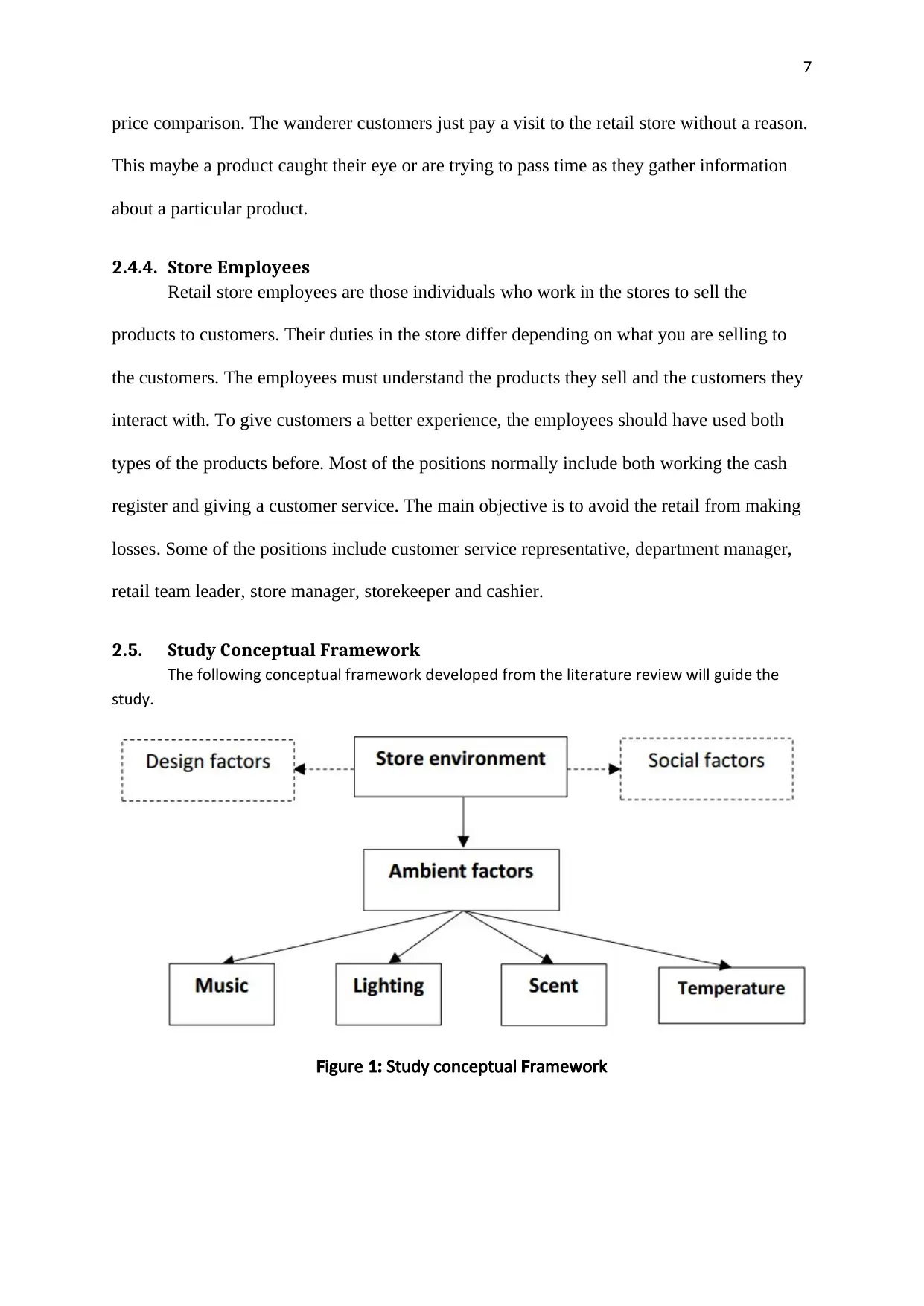
7
price comparison. The wanderer customers just pay a visit to the retail store without a reason.
This maybe a product caught their eye or are trying to pass time as they gather information
about a particular product.
2.4.4. Store Employees
Retail store employees are those individuals who work in the stores to sell the
products to customers. Their duties in the store differ depending on what you are selling to
the customers. The employees must understand the products they sell and the customers they
interact with. To give customers a better experience, the employees should have used both
types of the products before. Most of the positions normally include both working the cash
register and giving a customer service. The main objective is to avoid the retail from making
losses. Some of the positions include customer service representative, department manager,
retail team leader, store manager, storekeeper and cashier.
2.5. Study Conceptual Framework
he following conceptual framework developed from the literature review will guide theT
study.
igureF 1 Study conceptual ramework: F
price comparison. The wanderer customers just pay a visit to the retail store without a reason.
This maybe a product caught their eye or are trying to pass time as they gather information
about a particular product.
2.4.4. Store Employees
Retail store employees are those individuals who work in the stores to sell the
products to customers. Their duties in the store differ depending on what you are selling to
the customers. The employees must understand the products they sell and the customers they
interact with. To give customers a better experience, the employees should have used both
types of the products before. Most of the positions normally include both working the cash
register and giving a customer service. The main objective is to avoid the retail from making
losses. Some of the positions include customer service representative, department manager,
retail team leader, store manager, storekeeper and cashier.
2.5. Study Conceptual Framework
he following conceptual framework developed from the literature review will guide theT
study.
igureF 1 Study conceptual ramework: F
Paraphrase This Document
Need a fresh take? Get an instant paraphrase of this document with our AI Paraphraser
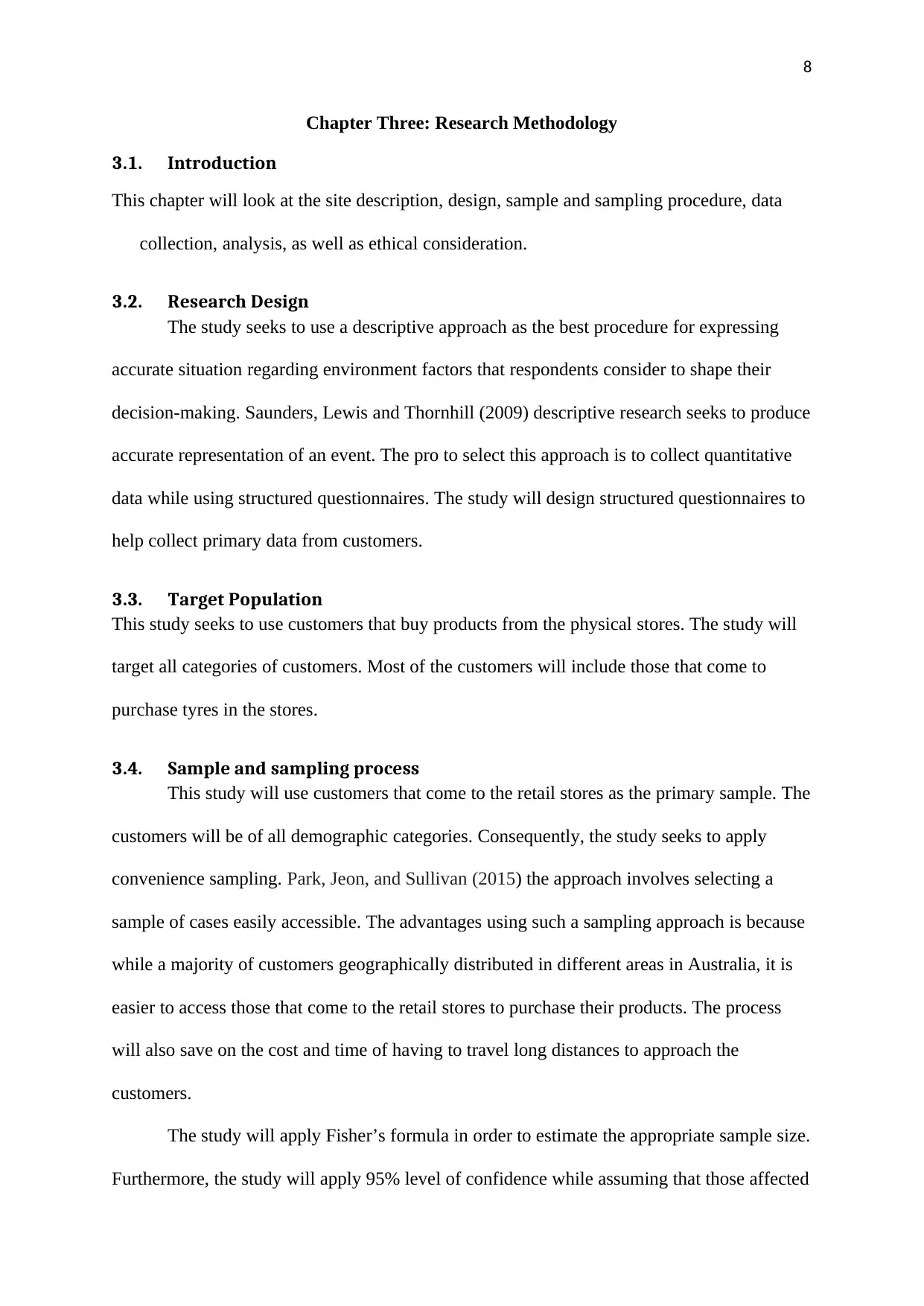
8
Chapter Three: Research Methodology
3.1. Introduction
This chapter will look at the site description, design, sample and sampling procedure, data
collection, analysis, as well as ethical consideration.
3.2. Research Design
The study seeks to use a descriptive approach as the best procedure for expressing
accurate situation regarding environment factors that respondents consider to shape their
decision-making. Saunders, Lewis and Thornhill (2009) descriptive research seeks to produce
accurate representation of an event. The pro to select this approach is to collect quantitative
data while using structured questionnaires. The study will design structured questionnaires to
help collect primary data from customers.
3.3. Target Population
This study seeks to use customers that buy products from the physical stores. The study will
target all categories of customers. Most of the customers will include those that come to
purchase tyres in the stores.
3.4. Sample and sampling process
This study will use customers that come to the retail stores as the primary sample. The
customers will be of all demographic categories. Consequently, the study seeks to apply
convenience sampling. Park, Jeon, and Sullivan (2015) the approach involves selecting a
sample of cases easily accessible. The advantages using such a sampling approach is because
while a majority of customers geographically distributed in different areas in Australia, it is
easier to access those that come to the retail stores to purchase their products. The process
will also save on the cost and time of having to travel long distances to approach the
customers.
The study will apply Fisher’s formula in order to estimate the appropriate sample size.
Furthermore, the study will apply 95% level of confidence while assuming that those affected
Chapter Three: Research Methodology
3.1. Introduction
This chapter will look at the site description, design, sample and sampling procedure, data
collection, analysis, as well as ethical consideration.
3.2. Research Design
The study seeks to use a descriptive approach as the best procedure for expressing
accurate situation regarding environment factors that respondents consider to shape their
decision-making. Saunders, Lewis and Thornhill (2009) descriptive research seeks to produce
accurate representation of an event. The pro to select this approach is to collect quantitative
data while using structured questionnaires. The study will design structured questionnaires to
help collect primary data from customers.
3.3. Target Population
This study seeks to use customers that buy products from the physical stores. The study will
target all categories of customers. Most of the customers will include those that come to
purchase tyres in the stores.
3.4. Sample and sampling process
This study will use customers that come to the retail stores as the primary sample. The
customers will be of all demographic categories. Consequently, the study seeks to apply
convenience sampling. Park, Jeon, and Sullivan (2015) the approach involves selecting a
sample of cases easily accessible. The advantages using such a sampling approach is because
while a majority of customers geographically distributed in different areas in Australia, it is
easier to access those that come to the retail stores to purchase their products. The process
will also save on the cost and time of having to travel long distances to approach the
customers.
The study will apply Fisher’s formula in order to estimate the appropriate sample size.
Furthermore, the study will apply 95% level of confidence while assuming that those affected
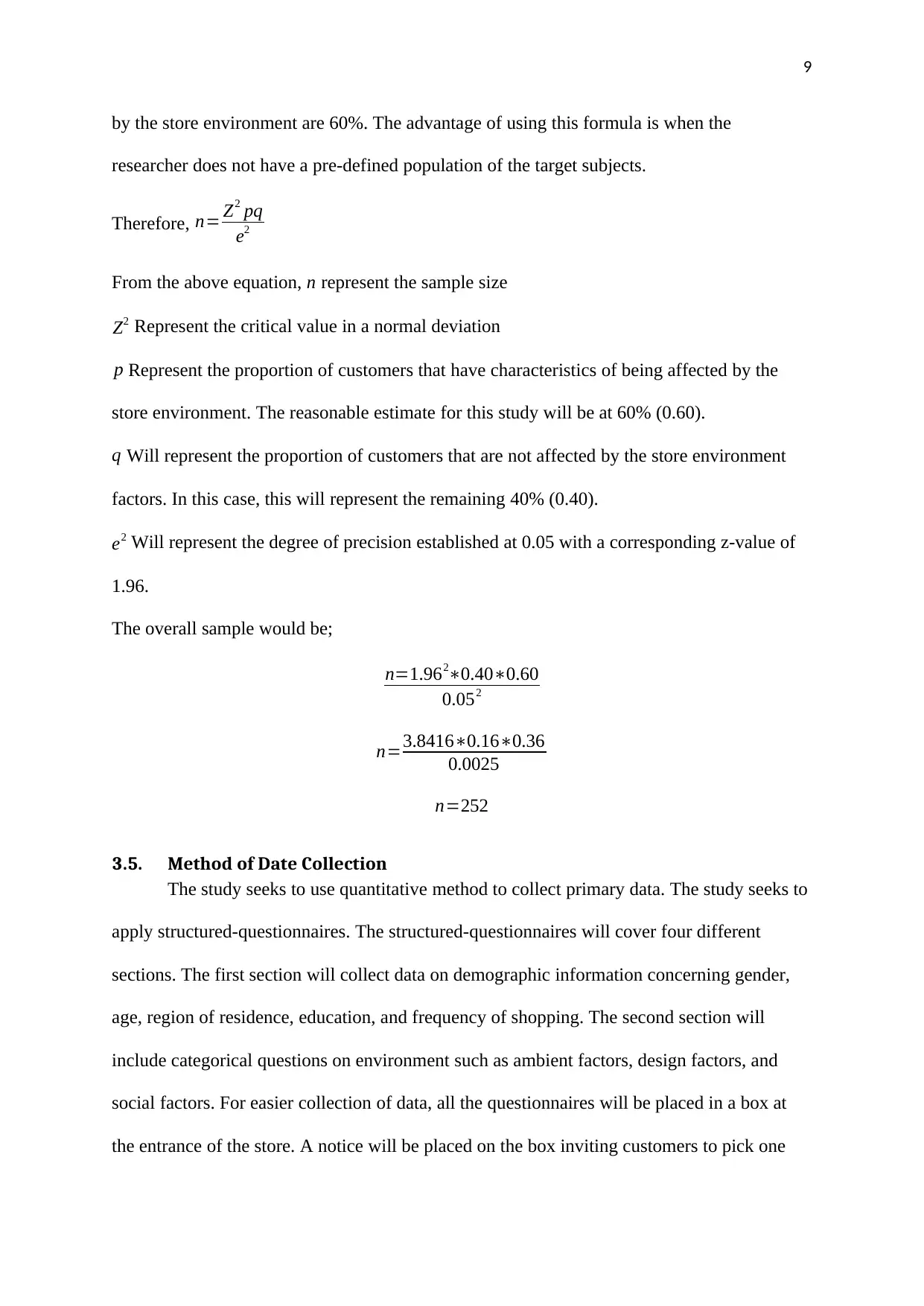
9
by the store environment are 60%. The advantage of using this formula is when the
researcher does not have a pre-defined population of the target subjects.
Therefore, n= Z2 pq
e2
From the above equation, n represent the sample size
Z2 Represent the critical value in a normal deviation
p Represent the proportion of customers that have characteristics of being affected by the
store environment. The reasonable estimate for this study will be at 60% (0.60).
q Will represent the proportion of customers that are not affected by the store environment
factors. In this case, this will represent the remaining 40% (0.40).
e2 Will represent the degree of precision established at 0.05 with a corresponding z-value of
1.96.
The overall sample would be;
n=1.962∗0.40∗0.60
0.052
n=3.8416∗0.16∗0.36
0.0025
n=252
3.5. Method of Date Collection
The study seeks to use quantitative method to collect primary data. The study seeks to
apply structured-questionnaires. The structured-questionnaires will cover four different
sections. The first section will collect data on demographic information concerning gender,
age, region of residence, education, and frequency of shopping. The second section will
include categorical questions on environment such as ambient factors, design factors, and
social factors. For easier collection of data, all the questionnaires will be placed in a box at
the entrance of the store. A notice will be placed on the box inviting customers to pick one
by the store environment are 60%. The advantage of using this formula is when the
researcher does not have a pre-defined population of the target subjects.
Therefore, n= Z2 pq
e2
From the above equation, n represent the sample size
Z2 Represent the critical value in a normal deviation
p Represent the proportion of customers that have characteristics of being affected by the
store environment. The reasonable estimate for this study will be at 60% (0.60).
q Will represent the proportion of customers that are not affected by the store environment
factors. In this case, this will represent the remaining 40% (0.40).
e2 Will represent the degree of precision established at 0.05 with a corresponding z-value of
1.96.
The overall sample would be;
n=1.962∗0.40∗0.60
0.052
n=3.8416∗0.16∗0.36
0.0025
n=252
3.5. Method of Date Collection
The study seeks to use quantitative method to collect primary data. The study seeks to
apply structured-questionnaires. The structured-questionnaires will cover four different
sections. The first section will collect data on demographic information concerning gender,
age, region of residence, education, and frequency of shopping. The second section will
include categorical questions on environment such as ambient factors, design factors, and
social factors. For easier collection of data, all the questionnaires will be placed in a box at
the entrance of the store. A notice will be placed on the box inviting customers to pick one
⊘ This is a preview!⊘
Do you want full access?
Subscribe today to unlock all pages.

Trusted by 1+ million students worldwide
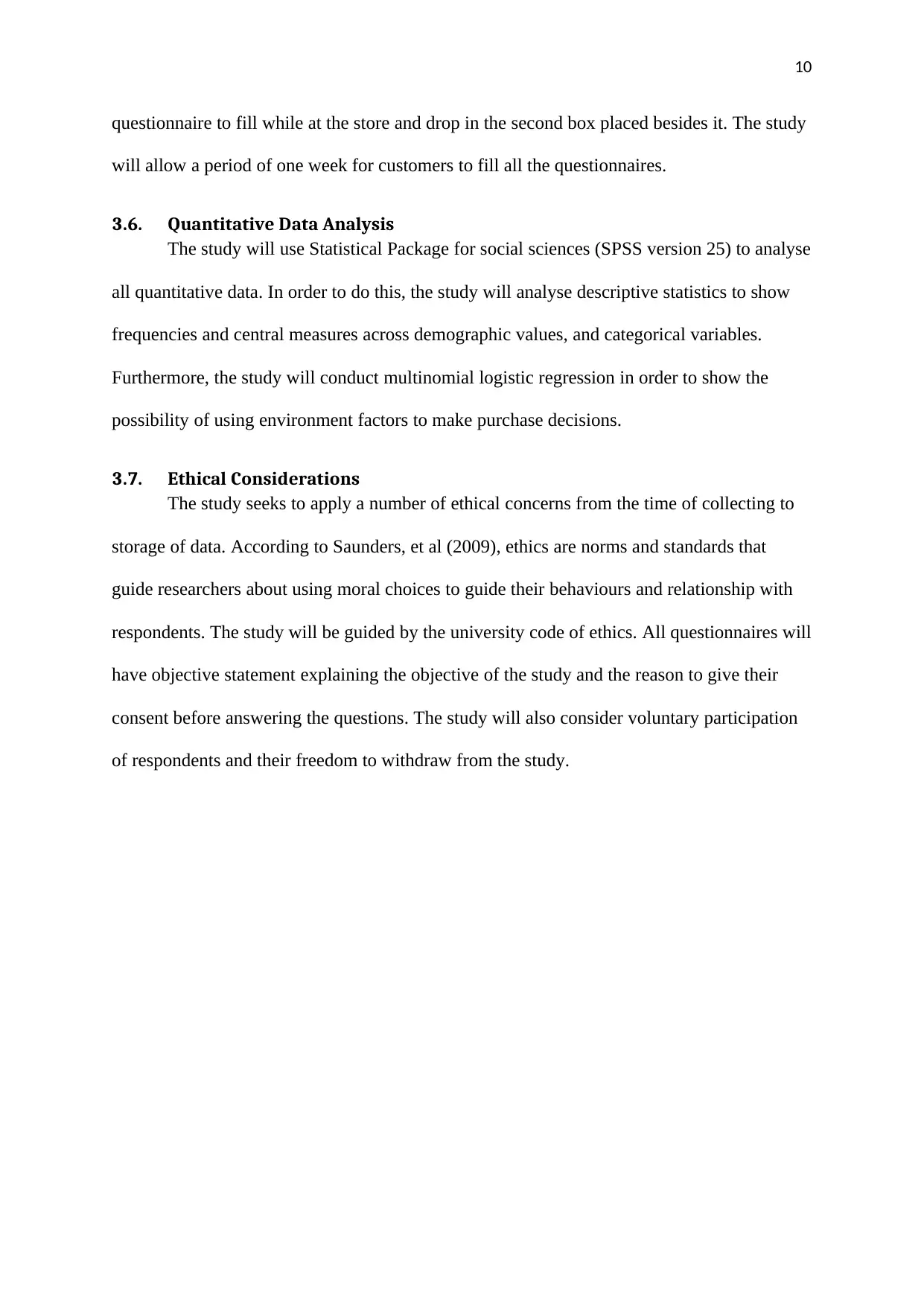
10
questionnaire to fill while at the store and drop in the second box placed besides it. The study
will allow a period of one week for customers to fill all the questionnaires.
3.6. Quantitative Data Analysis
The study will use Statistical Package for social sciences (SPSS version 25) to analyse
all quantitative data. In order to do this, the study will analyse descriptive statistics to show
frequencies and central measures across demographic values, and categorical variables.
Furthermore, the study will conduct multinomial logistic regression in order to show the
possibility of using environment factors to make purchase decisions.
3.7. Ethical Considerations
The study seeks to apply a number of ethical concerns from the time of collecting to
storage of data. According to Saunders, et al (2009), ethics are norms and standards that
guide researchers about using moral choices to guide their behaviours and relationship with
respondents. The study will be guided by the university code of ethics. All questionnaires will
have objective statement explaining the objective of the study and the reason to give their
consent before answering the questions. The study will also consider voluntary participation
of respondents and their freedom to withdraw from the study.
questionnaire to fill while at the store and drop in the second box placed besides it. The study
will allow a period of one week for customers to fill all the questionnaires.
3.6. Quantitative Data Analysis
The study will use Statistical Package for social sciences (SPSS version 25) to analyse
all quantitative data. In order to do this, the study will analyse descriptive statistics to show
frequencies and central measures across demographic values, and categorical variables.
Furthermore, the study will conduct multinomial logistic regression in order to show the
possibility of using environment factors to make purchase decisions.
3.7. Ethical Considerations
The study seeks to apply a number of ethical concerns from the time of collecting to
storage of data. According to Saunders, et al (2009), ethics are norms and standards that
guide researchers about using moral choices to guide their behaviours and relationship with
respondents. The study will be guided by the university code of ethics. All questionnaires will
have objective statement explaining the objective of the study and the reason to give their
consent before answering the questions. The study will also consider voluntary participation
of respondents and their freedom to withdraw from the study.
Paraphrase This Document
Need a fresh take? Get an instant paraphrase of this document with our AI Paraphraser
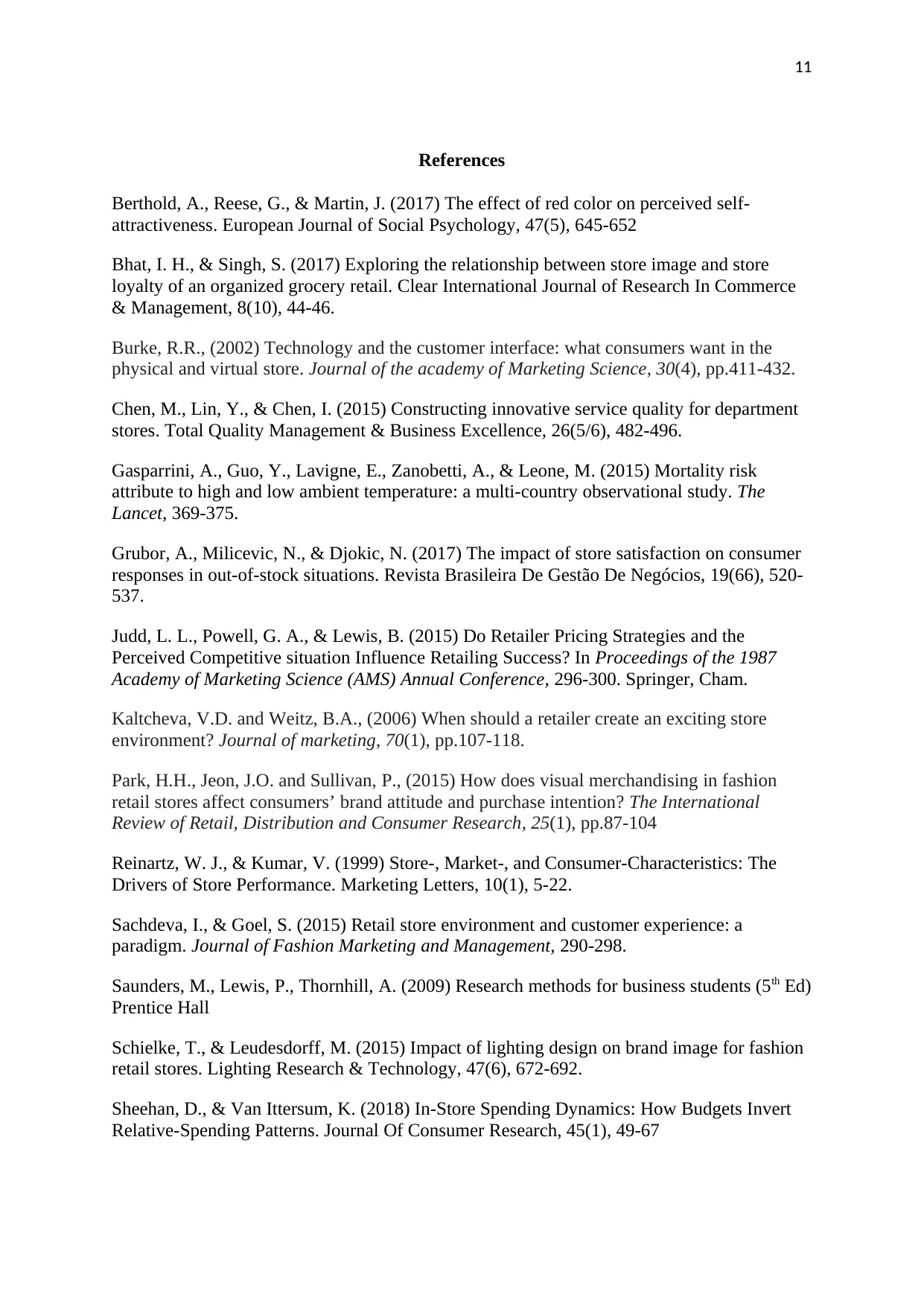
11
References
Berthold, A., Reese, G., & Martin, J. (2017) The effect of red color on perceived self-
attractiveness. European Journal of Social Psychology, 47(5), 645-652
Bhat, I. H., & Singh, S. (2017) Exploring the relationship between store image and store
loyalty of an organized grocery retail. Clear International Journal of Research In Commerce
& Management, 8(10), 44-46.
Burke, R.R., (2002) Technology and the customer interface: what consumers want in the
physical and virtual store. Journal of the academy of Marketing Science, 30(4), pp.411-432.
Chen, M., Lin, Y., & Chen, I. (2015) Constructing innovative service quality for department
stores. Total Quality Management & Business Excellence, 26(5/6), 482-496.
Gasparrini, A., Guo, Y., Lavigne, E., Zanobetti, A., & Leone, M. (2015) Mortality risk
attribute to high and low ambient temperature: a multi-country observational study. The
Lancet, 369-375.
Grubor, A., Milicevic, N., & Djokic, N. (2017) The impact of store satisfaction on consumer
responses in out-of-stock situations. Revista Brasileira De Gestão De Negócios, 19(66), 520-
537.
Judd, L. L., Powell, G. A., & Lewis, B. (2015) Do Retailer Pricing Strategies and the
Perceived Competitive situation Influence Retailing Success? In Proceedings of the 1987
Academy of Marketing Science (AMS) Annual Conference, 296-300. Springer, Cham.
Kaltcheva, V.D. and Weitz, B.A., (2006) When should a retailer create an exciting store
environment? Journal of marketing, 70(1), pp.107-118.
Park, H.H., Jeon, J.O. and Sullivan, P., (2015) How does visual merchandising in fashion
retail stores affect consumers’ brand attitude and purchase intention? The International
Review of Retail, Distribution and Consumer Research, 25(1), pp.87-104
Reinartz, W. J., & Kumar, V. (1999) Store-, Market-, and Consumer-Characteristics: The
Drivers of Store Performance. Marketing Letters, 10(1), 5-22.
Sachdeva, I., & Goel, S. (2015) Retail store environment and customer experience: a
paradigm. Journal of Fashion Marketing and Management, 290-298.
Saunders, M., Lewis, P., Thornhill, A. (2009) Research methods for business students (5th Ed)
Prentice Hall
Schielke, T., & Leudesdorff, M. (2015) Impact of lighting design on brand image for fashion
retail stores. Lighting Research & Technology, 47(6), 672-692.
Sheehan, D., & Van Ittersum, K. (2018) In-Store Spending Dynamics: How Budgets Invert
Relative-Spending Patterns. Journal Of Consumer Research, 45(1), 49-67
References
Berthold, A., Reese, G., & Martin, J. (2017) The effect of red color on perceived self-
attractiveness. European Journal of Social Psychology, 47(5), 645-652
Bhat, I. H., & Singh, S. (2017) Exploring the relationship between store image and store
loyalty of an organized grocery retail. Clear International Journal of Research In Commerce
& Management, 8(10), 44-46.
Burke, R.R., (2002) Technology and the customer interface: what consumers want in the
physical and virtual store. Journal of the academy of Marketing Science, 30(4), pp.411-432.
Chen, M., Lin, Y., & Chen, I. (2015) Constructing innovative service quality for department
stores. Total Quality Management & Business Excellence, 26(5/6), 482-496.
Gasparrini, A., Guo, Y., Lavigne, E., Zanobetti, A., & Leone, M. (2015) Mortality risk
attribute to high and low ambient temperature: a multi-country observational study. The
Lancet, 369-375.
Grubor, A., Milicevic, N., & Djokic, N. (2017) The impact of store satisfaction on consumer
responses in out-of-stock situations. Revista Brasileira De Gestão De Negócios, 19(66), 520-
537.
Judd, L. L., Powell, G. A., & Lewis, B. (2015) Do Retailer Pricing Strategies and the
Perceived Competitive situation Influence Retailing Success? In Proceedings of the 1987
Academy of Marketing Science (AMS) Annual Conference, 296-300. Springer, Cham.
Kaltcheva, V.D. and Weitz, B.A., (2006) When should a retailer create an exciting store
environment? Journal of marketing, 70(1), pp.107-118.
Park, H.H., Jeon, J.O. and Sullivan, P., (2015) How does visual merchandising in fashion
retail stores affect consumers’ brand attitude and purchase intention? The International
Review of Retail, Distribution and Consumer Research, 25(1), pp.87-104
Reinartz, W. J., & Kumar, V. (1999) Store-, Market-, and Consumer-Characteristics: The
Drivers of Store Performance. Marketing Letters, 10(1), 5-22.
Sachdeva, I., & Goel, S. (2015) Retail store environment and customer experience: a
paradigm. Journal of Fashion Marketing and Management, 290-298.
Saunders, M., Lewis, P., Thornhill, A. (2009) Research methods for business students (5th Ed)
Prentice Hall
Schielke, T., & Leudesdorff, M. (2015) Impact of lighting design on brand image for fashion
retail stores. Lighting Research & Technology, 47(6), 672-692.
Sheehan, D., & Van Ittersum, K. (2018) In-Store Spending Dynamics: How Budgets Invert
Relative-Spending Patterns. Journal Of Consumer Research, 45(1), 49-67
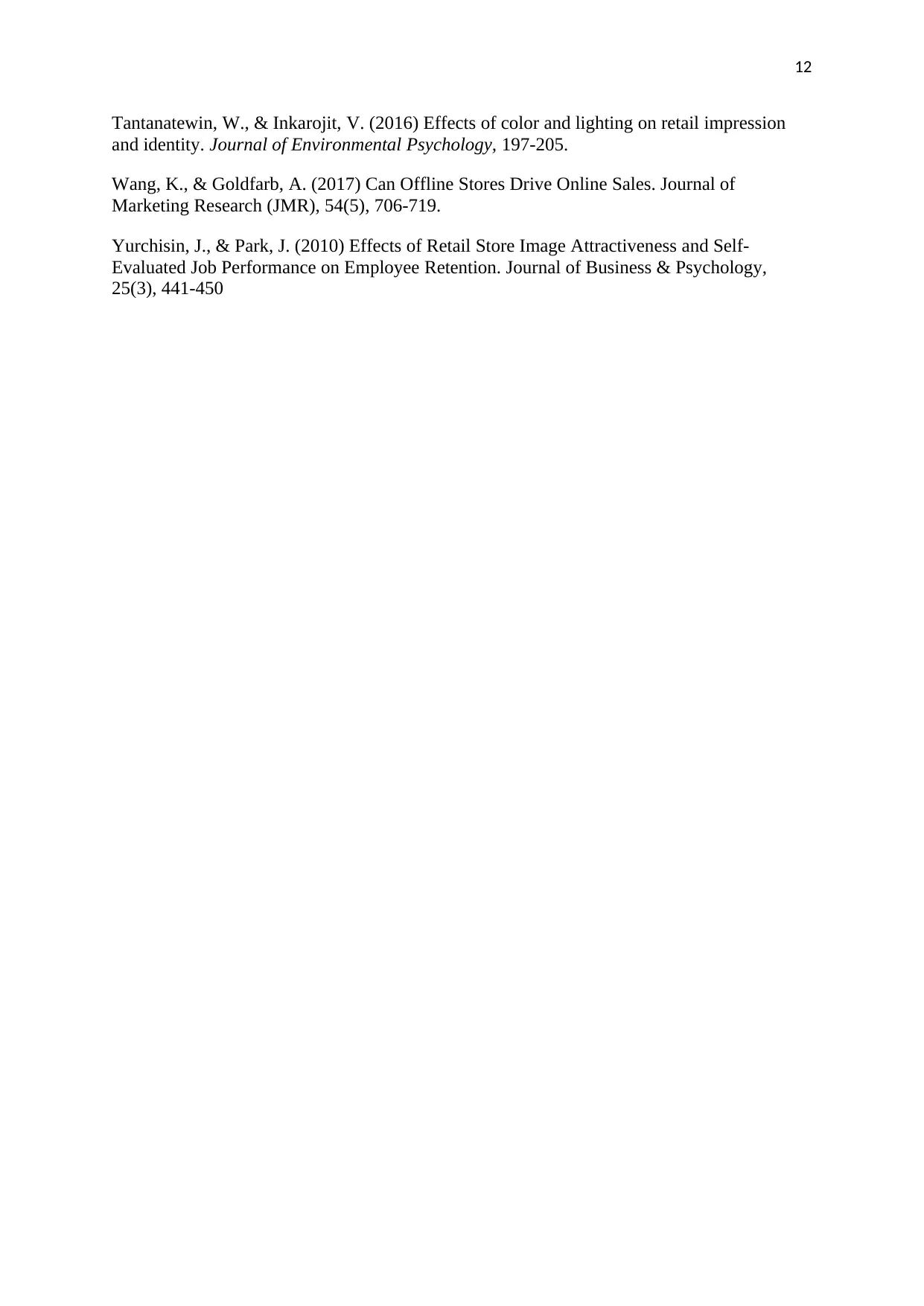
12
Tantanatewin, W., & Inkarojit, V. (2016) Effects of color and lighting on retail impression
and identity. Journal of Environmental Psychology, 197-205.
Wang, K., & Goldfarb, A. (2017) Can Offline Stores Drive Online Sales. Journal of
Marketing Research (JMR), 54(5), 706-719.
Yurchisin, J., & Park, J. (2010) Effects of Retail Store Image Attractiveness and Self-
Evaluated Job Performance on Employee Retention. Journal of Business & Psychology,
25(3), 441-450
Tantanatewin, W., & Inkarojit, V. (2016) Effects of color and lighting on retail impression
and identity. Journal of Environmental Psychology, 197-205.
Wang, K., & Goldfarb, A. (2017) Can Offline Stores Drive Online Sales. Journal of
Marketing Research (JMR), 54(5), 706-719.
Yurchisin, J., & Park, J. (2010) Effects of Retail Store Image Attractiveness and Self-
Evaluated Job Performance on Employee Retention. Journal of Business & Psychology,
25(3), 441-450
⊘ This is a preview!⊘
Do you want full access?
Subscribe today to unlock all pages.

Trusted by 1+ million students worldwide
1 out of 12
Related Documents
Your All-in-One AI-Powered Toolkit for Academic Success.
+13062052269
info@desklib.com
Available 24*7 on WhatsApp / Email
![[object Object]](/_next/static/media/star-bottom.7253800d.svg)
Unlock your academic potential
Copyright © 2020–2025 A2Z Services. All Rights Reserved. Developed and managed by ZUCOL.




